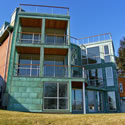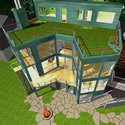|
Boston
Architecture
(AFR):
You are right in the heart of Boston. Historic Charlestown
is a very conservative architectural environment—despite
all of the 21st century technologies surrounding it.
Things are rooted here in tradition. So what are some
of the specific challenges you face in trying to respond
to that history in what you are doing?
(BA): It
seems like the outcome is a controversial one. Not from
my point of view because I understand it. What I am finding
is that most people either really do love these things
or hate them.
So
it is a love [or] hate relationship with your architecture?
(BA): I
don't mind that at all. The worst thing that can
happen is that people don't care. Even so, in an odd way I
feel I am building for the future.
Right.
It is worse if they don't notice the architecture
at all?
(BA): It
seems to effect them emotionally. Look, I had a woman
call on the phone. She said, "is this the architect
of the house on Grove Street? It is hideous". A
week later I got another call from someone walking their
dog from out of town and they said "this is the
coolest house I have ever seen". Same thing with
the neighbors, some people love it, others want to call
the cops.

Controversy
can often be a good thing in the arts, in this town controversy
can be tough.
(BA): I
am not quite sure why because it is for odd things. For
example, flat roofs in Cambridge. We did 4 units over
on Bella Circle. People thought how absurd that it
has flat roofs. I think I opened people's minds
because I reminded them that half of the building stock
in Cambridge have flat roofs. Maybe it is a "class" idea
of housing: flat roof verses pitch roof, worker housing
versus proper housing. There certainly is attitude about
different types of housing. I am amazed that people don't
look at their environment more when they judge modern
architecture. They only look at part of their environment,
the part they want to see.
Does
this controversy bother you? Even a little?
(BA): In
find the controversy stimulating. There
are so many ways to go in practice. There are so many
great architects that do traditional buildings -- more
power to them. "I love this". I think there
is a growing market for this kind of edge.
 |
 |
 |
| Commanding
views and abundant sunlight (left and middle). Use
of ArchiCAD's state-of-the-art BIM (building information
modeling) technology allowed architect Bob Augustine
to communicate to developer/builder effectively. Bellis
Circle housing struck controversy in Cambridge, Massachusetts,
a city with extensive and varied use of flat roofs
in existent housing stock (right). |
You
were in the Boston Globe "Modern Love" article.
It implies that there are Bostonians out there wanting
modern architecture.
(BA): I
don't think the market is as big for modern architecture
as for the traditional market or builder market. I think
it is twenty percent of the total market. But for people
who want it, there isn't anything out there. These people
want jazz, personality.
I look at what is out there and there is nothing. They would
buy it if they could get it and the towns made it easier
for us to build it.
There
is a lot of talk of the Baby Boomers leaving their large
homes in the suburbs and coming into the city. They
are moving into sleek buildings glass, modern design.
They are moving into modernism which can be found in
upscale urban living. Is this the same phenomena as you
were
saying before that some people want more progressive
architecture, wanting less tradition? What do you think
this market is?
The
Creative Class: Luxury and Desire
(BA): There
is an author that wrote a book called "Building
for the Creative Class" (Richard Florida).
He talks about a creative class of home owners
which
live
in worker
housing. These workers are not brick layers but
professionals working at Harvard, in technologies,
artists, one of my clients is a retro pop girls
band member, another is an architect. Florida argues
that supporting this creative class is essential
if our cities are to survive and thrive. It is
an unusual mix of people. I think what has happened
is there is nothing out there for these folks,
nothing at all. Someone who is up-and-coming in
the world is looking around to find a fresh expression
that isn't living in the past. On the other hand,
it can be so ironic, some rock bands get successful
and the next thing you know they move into a tutor
mansion.

(AFR):
Do you think that traditional architecture like tudor
mansions symbolize money, therefore symbolize success?
(BA): Yes,
it symbolizes the dollar bill, making it.
That's
interesting, the irony there. People can be so successful
through "counter-cultural" means but once
they reach success they contradict themselves through
architecture.
Do
you believe there can be a new kind of architecture that
becomes a new currency, a different way of symbolizing
"you have made it"?
(BA): I
do feel architecture can be a currency for new alliances
and new values. Making it becomes getting it.
Not
sure what you mean by that...
(BA): It
is challenging that status quo with some fresh thinking.
If you don't have anybody playing up against tradition
than tradition doesn't change.
(AFR)
Apple has on some level always been considered a luxury
brand for its computers. Then
comes along the iPod, reasonably price-competitive and
a huge mass-market hit. Has Apple broken the luxury symbolism
with its newfound success?
(BA): It's
different than that. For me their design has always created
desire. I am not sure why this is.
But
is it the same type of desire that causes the successful
rock band to desire -- and acquire -- the Tudor
mansion?
(BA): I
don't think so. It is a desire to be different, to
deal with the world in new ways. It can make new associations.
Their design inspires us to sample and reframe our
world. It is counter-cultural.
Actually
I wish Apple
might
play
a bigger
part
in the
technology of our profession, in architecture.
next
page > | 1 | 2 | 3 | 4 |
Other Firm Profiles
Firm
Profile: Helsinki Architects Push BIM Agenda on Macs
Firm
Profile: Flansburgh Associates
Firm
Profile: LuminetIK
Firm
Profile: Of the Place Itself: A vernacular Modernism in
Austin |






![]()
![]()